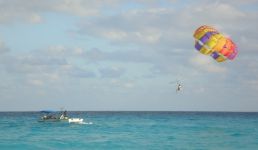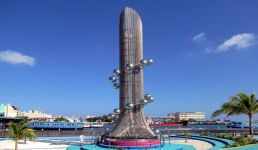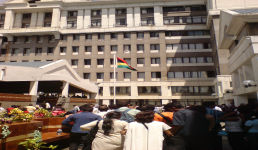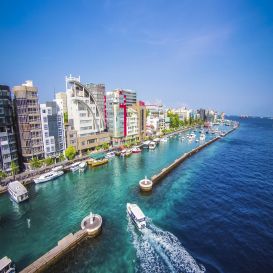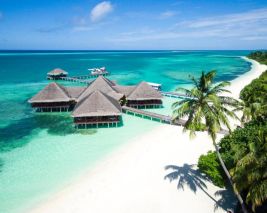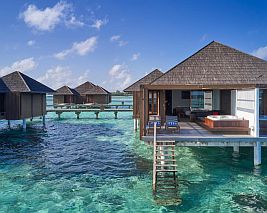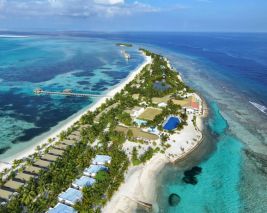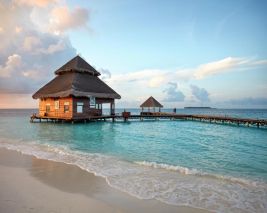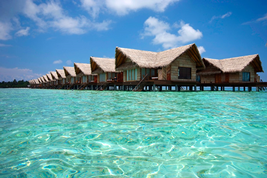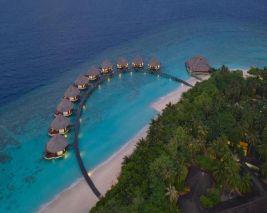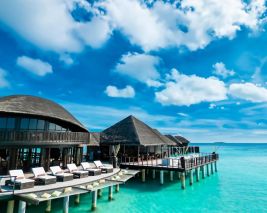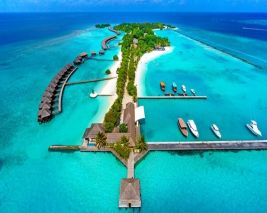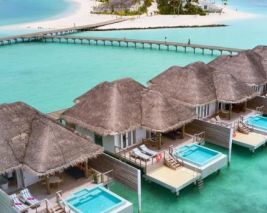Have you ever answered the question – if you were stuck on an island, what would you bring? Books, people, food, some form of entertainment. Well, luckily, the island we’re going to describe today needs none of the above. You only step onto the soft, warm sand of the beaches, feel the blue-green waves slip under your feet and in between your toes, hear the beat of the music, and smell the lime, coconut and chilli of a tangy fish soup to understand that this island nation needs nothing to make it better.
You would’ve already made a guess that we are talking about Maldives. The place has almost everything-picture-perfect beaches, around 1192 coral islands, lavish villas, delicious food, and whatnot. So, no matter what you've in your mind, a relaxing vacation with your friends or a luxury detour for yourself, Maldives tourism has got you covered. So, today, we’re going to give you a small insight into this ocean-bound treasure. We’ll dive under the water, we’ll walk the streets, learn about the history and explore the best of Maldives Tourism, including its nature, wildlife, cuisine, Maldives tourism prices, and much more. Let’s dive in!
|
Maldives Tourism- A Quick Overview
|
|
Continent
|
Asia
|
|
Capital City
|
Male
|
|
Official Language
|
Dhivehi
|
|
Dial Code
|
+960
|
|
Population
|
530, 953
|
|
Currency
|
Maldivian rufiyaa
|
|
Time Zone
|
(GMT+5)
|
|
Area
|
297.8 sq. km
|
Highlights of Maldives
Cities and Islands in Maldives
The Maldives island nation is a cluster of precious jewels – discovering each of them is a pleasure and delight. When talking of places to visit in Maldives, you cannot simply miss talking about Malé – the capital city, in fact, one of the smallest capital cities across the globe that captures your heart and fulfils your soul. Thrumming with energy, this is a city filled with beautiful buildings, like the 17th century Friday Mosque, Grand Friday Mosque, and National Museum. Then you may continue exploring Maldives tourism with energetic markets like Male Market and the lovely Mulee Aage Palace.
In addition to that, you can also give a shot to underground water photoshoots or private photography sessions if you want to seize the moment. Now, Cross the sparkling waters that surround Male and you’ll arrive at the Hulhumale Island, with its spectacular beaches, glass topped mosque, a beautiful promenade and serene, green neighbourhoods. If you’re going slightly off the well-trodden path, then Maafushi is the destination to visit. Once ravaged by the tsunami, this island is climbing back on its feet, with a variety of beautiful resorts springing up. This is a quiet, beautiful pocket of the world to tuck yourself into. Stroll on the beaches, laze at the guesthouse and enjoy coffee at its small coffeehouses. For a little history, head to the northernmost of the Maldivian island chains to the island of Utheemu – once the home of Sultan Mohammed Thakurufaanu, the leader who drove the Portuguese invaders from the islands in the 16th century. Other places to visit are Feydhoo, Maradhoo, Veligandu Island, Banana Reef, Thulusdhoo Island and more.
Shopping at Maldives
The Maldives isn’t the shopping hub of the world, but there are beautiful souvenirs to buy from the many markets that crowd the islands. One of the first places to visit in Maldives for an unforgettable shopping experience is the Male Local Market. This exciting bazaar sells gorgeous handicrafts, mementoes and more. Pick up packaged sweetmeats, boat souvenirs, seashell home décor and silky coconut milk. The local market is also where you can get fresh fruits and local vegetables. Best part? You can also pick gifts for your loved ones from the duty-free shops at Male Airport. The next market on your list should be Majeedhee Magu, where local cosmetics, dried fish chips, canned smoked fish, jewellery, electronics, and clothes are all yours to choose from. Forgotten your toiletries at home? Then, wander over to Le Cute – the Maldives most famous beauty and cosmetics shop. Healthcare, herbal, perfumes and more – you’ll find them all here. For a more curated shopping experience, visit Island Bazaar – classy, elegant and expensive, you’ll find intricate handicrafts, bags, décor, handmade jewellery, scarves and handmade dishes.
Nature and Wildlife in Maldives
One of the best parts of Maldives tourism is its exotic flora and fauna and diverse wildlife. Such beauty has always been a centre of attraction for wildlife enthusiasts and travellers all across the globe. The blue and green of Maldives conceal worlds of wildlife and marine life. Fruit bats, lizards of every colour, slinky snakes, turtles swirling their way under the water, beautiful pelagic birds, whales and dolphins twisting in the water, hammerhead sharks shyly slipping through the massive coral reefs, sting rays gliding across the ocean floor, thousands and thousands of schools of colourful fish. You need to plunge into the wonder of this environment to see them all. Explore the underwater kingdom from popular dive sites like Sun Island, Broken Rock, Maaya Thila, Banana Reef and Alimatha Jetty.
Did you know? The Maldives wildlife, consisting of some sharks, turtles, and corals, are already under threat caused by global warming and intense climate change. So, wait no more and get the best and most out of Maldives tourism before it gets too late.
Cuisine of Maldives
Light, fresh, tinged with every kind of spice – the cuisine in the Maldives is delicious. You must try Garudhiya at least once during your trip. This fragrant fish soup is served with rice, chilli, lemon and onions. For more seafood specials, go for a plate of Mas Huni – smoked and shredded tuna sprinkled with lemon, coconut and onions. For a lighter fare, Masroshi is a must – chapati stuffed with flaky tuna and coconut.
For that crunchy, crispy goodness Bis Keemiya is on point – a crisp pastry stuffed with hardboiled egg (or tuna), sliced onions and shredded cabbage. For a healthier option, try Boshi Mashuni – a mix of shredded banana flowers, coconut all gently spiked with turmeric, cumin, lime and Maldivian chilli. For a mid-day snack, you can’t do better than crispy fried yams served with a variety of dips. End on a sweet note with Saagu Bondibai – sago softened with coconut milk and condensed milk, flooded with the essence of cardamom and rose.
Interesting facts about Maldives
- The world’s first underwater cabinet meeting was held here, to highlight climate change and rising ocean levels.
- The island was formed by an exiled Indian prince – Sri Soorudasaruna Adeettiya - according to legend.
- The Maldives is comprised of more than 1190 coral islands.
- You will only find alcohol in hotels and resorts as the country is an Islamic nation.
- The literacy rate here is close to 98 percent.
Location of Maldives
Found in the swirling Arabian Sea (part of the larger Indian ocean) this small South Asian island nation lies southwest of Sri Lanka and India and around 1,000 kilometres from the Asian continent. The Maldives is comprised of 26 atolls (a ring-shaped coral reef that encircles a lagoon partially or completely). Some atolls form islands and some are isolated reefs.
Best time to visit Maldives
Planning your next trip to Maldives already? Then it's natural to wonder what is the best time to visit Maldives. Well, let's help you with that. The sun loves Maldives! Blue skies, gentle waves and the warm sun - perfect weather for all those great beach days. However, the best time to visit this island nation is from November to April (with the best weather conditions peaking between December and March).
The rain around this time is little, and so is humidity, meaning clear skies, and calming evenings. The Maldives do experience a monsoon season – between May and October. The strong winds and rain season may not offer you the best conditions that align with the activities you've planned for yourself on the trip. So, choose the best time to visit Maldives wisely. So choose the best time to visit Maldives wishly
How to reach the Maldives
Now comes the next important question: how to reach Maldives. Well, considering the global connectivity and modern, technical advancements, you can go anywhere in the world, without wasting much of your time and with reduced hassle. And Maldives is no exception.
By Air: Booking a flight to the Maldives? You’ll either land at Malé Airport – the largest airport in the country or Gan Airport in Addu city. There are domestic airports, like Kaadedhdhoo Airport and Hanimaadhoo Airport, in case you want to travel within the country. The International Airports are well connected, with flights from India, China and Sri Lanka. You can also catch a direct flight from Dubai, or chartered flights from Singapore or Europe. The air route is easy and faster, and you can book your tickets at affordable prices, keeping your Maldives tourism cost in check.
You can also choose the cruise route for yourself if you're looking for a more relaxed, luxurious vibe. The time taken might be longer, but the experience is surely worth the time. Further, the cruise can be comparatively expensive, ultimately increasing your Maldives tourism prices; however, with it,, you also enjoy shore excursions, delicious meals, and much more worth every penny.
All in all, your Maldives tourism cost can vary based on several factors, including your accommodation, tour packages, transportation, and so on. You can also check out more ways on How to Reach Maldives
History of Maldives
Although early Maldivians did not leave any archaeological artefacts, experts believed that their homes and settlements were decimated in the tropical climate. Studies have suggested, though, that the first settlers were from the neighbouring Indian subcontinent – with strong Tamilian and Malayalam influences seen in the language, poetry, names, dance and religious beliefs. In the 12th century, Islam was introduced to the Maldives and was consolidated as a Sultanate. During the 16th century, the nation slid under European colonial powers. The Maldives officially became a British protectorate in 1887. It was in 1965 that the country was granted independence from the United Kingdom. A presidential republic was established in 1968.
Avoid missing anything major on Maldives tourism, including the history, culture, local language, and food, alongside its wildlife and fun activities, with a Maldives travel guide.


















